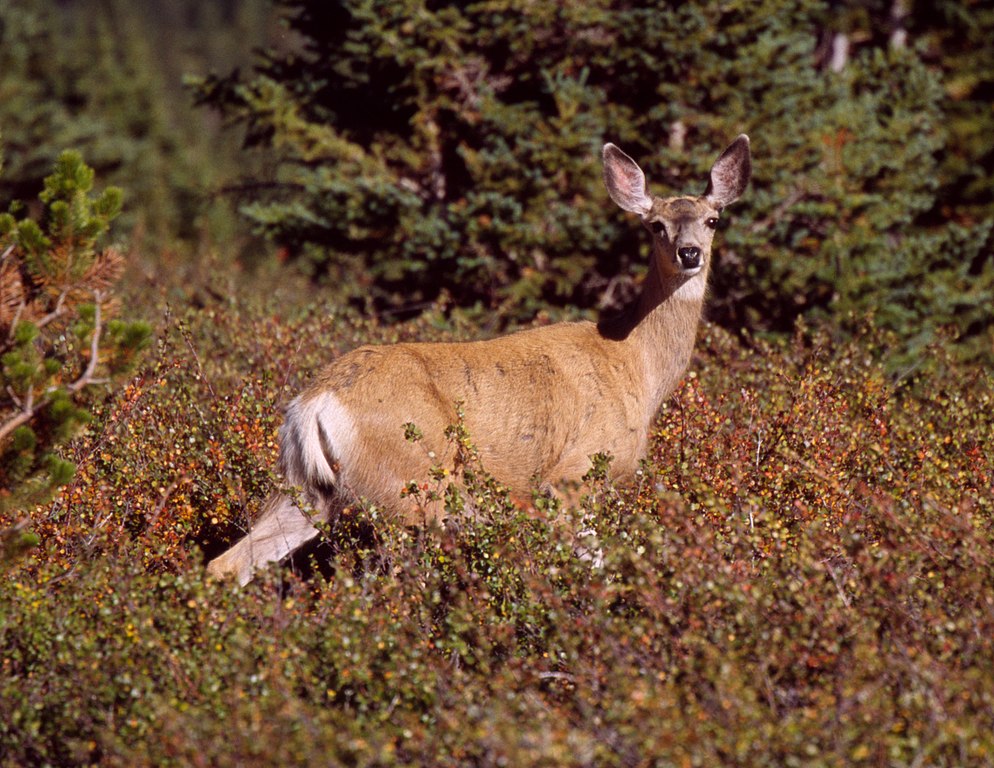.

Mule Deer (Odocoileus hemionus): photo by Arthur Mouratidis, 2006
....A mountain temple:
The voice of the stag,
....On the verandah.
-- Issa
The temple in this wild, out-of-the-way mountain is visited by few people, and the wild deer come so near that when a stag roars in the rutting season, it sounds as if it is standing on the verandah outside. We feel the closeness of the world of nature and the world of man. But here in the temple before the images of Buddha, the animal world touches the divine. The voice of the stag mingles with the chanting of the sutra and the sound of the gong: Vox cervi vox dei.
....Having lighted a candle to the god,
On the way back,
....The voice of the deer.
-- Shiki
On the way back,
....The voice of the deer.
-- Shiki
The poet went to a nearby shrine in the early evening, lighted a candle, prayed, and returned to his house through the gathering autumn shadows. Now and again the cry of an unseen deer was heard from the mountain side. What is this strange harmony between the uprising yellow flame of the candle burning like a soul of fire in his mind, and the voice of the deer that comes through the darkness and fades into the distance? The light of the candle is the visible voice of matter, the cry of the deer the audible flame of life. How then should they seem anything but a two in one, a one in two, to the poetic mind?
....Three times it cried,
And was heard no more,
....The voice of the deer.
-- Buson
From olden times the voice of the deer was deemed a poetic thing, chiefly from its association with love and its lack of fulfilment or sad satiety, but from the time of Bashô it began to have a deeper meaning, a returning to nature for its own sake, as we see in the following verse.
....Hee.........the lingering cry
Is mournful:
....The deer at night.
-- Bashô
But even here the subjective element is too strong. Buson's verse achieves that subjective-objective level in which we are left without any feeling of reaction against wallowing in our own feelings, and yet not left out in the cold by a pure and artificial objectivity. The voice of the deer has a meaning which is not merely a non-human one, yet it is nameless; it leaves us where we are, and yet enlarges our vision and power beyond this present place.
....The slanting sun:
The shadow of a hill with a deer on it
....Enters the temple gate.
-- Buson
This is a picture in the Japanese style, but the lines are not static; they have some latent motion. This verse is one of the best examples of Buson's dynamic objectivity.
from R. H. Blyth: Haiku, Volume IV: Autumn-Winter (1951)
Mule Deer (Odocoileus hemionus), Inyo Crater Lakes, California: photo by Daniel Mayer, 2009

Mule Deer (Odocoileus hemionus), Bryce Canyon National Park: photo by James Phelps, 29 June 2006

Mule Deer (Odocoileus hemionus), Bryce Canyon National Park: photo by Dbenbenn, 14 February 2005

Mule Deer (Odocoileus hemionus), Zion Canyon: photo by Daniel Mayer, August 2004

Mule Deer (Odocoileus hemionus), Caprock Canyons, West Texas: photo by Leaflet, 15 May 2005

Sitka Black-tailed Deer (Odocoileus hemionus sitkensis), Kodiak National Wildlife Refuge: photo by Steve Hillebrand, 24 August 2006

Mule Deer (Odocoileus hemionus), male and female, Modoc County, California: photo by Tupper Ansel, 10 February 2005 (U.S. Fish and Wildlife Service)

Mule Deer (Odocoileus hemionus), doe, grazing, Clearwater Pass, Alberta: photo by Eddie (Alcazar Mountain), 24 August 2006

Mule Deer (Odocoileus hemionus), Jasper Park, Canada: photo by Franco Folini, 8 September 2002

Columbian Black-tailed Deer (Odocoileus hemionus columbianus), Coast Deer, male, Olympic National Park: photo by Walter Siegmund, 3 July 2008

Columbian Black-tailed Deer (Odocoileus hemionus columbianus), Coast Deer, male, Olympic National Park: photo by Walter Siegmund, 3 July 2008

Columbian Black-tailed Deer (Odocoileus hemionus columbianus), Coast Deer, male, Olympic National Park: photo by Walter Siegmund, 4 July 2008

Columbian Black-tailed Deer (Odocoileus hemionus sitkensis), doe, in fog, Olympic National Park: photo by Walter Siegmund, 4 July 2008

No comments:
Post a Comment